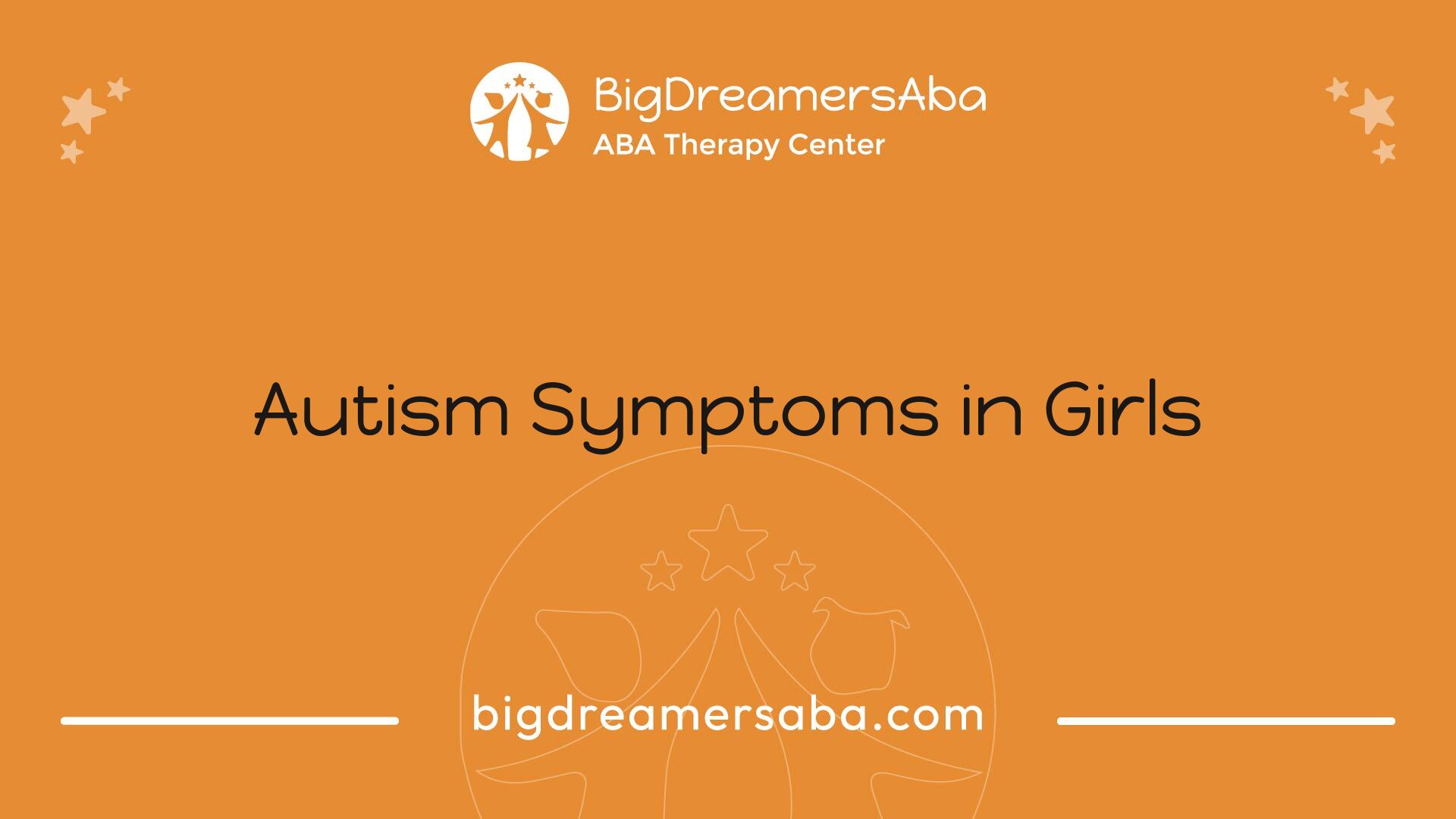Autism Symptoms in Girls
Discover autism symptoms in girls, including early signs, treatment strategies, and gender disparities.

Understanding Autism Symptoms in Girls

Understanding the symptoms of autism in females requires attention to early signs and the potential for regression, which can be unique compared to their male counterparts.
Early Signs and Detection
The behavioral symptoms of autism spectrum disorder (ASD) often present themselves early in life, with many children exhibiting symptoms by 12 to 18 months of age or even earlier. Parents might not recognize these signs until their child fails to reach typical speech milestones. Most children receive a diagnosis after age 3, despite healthcare providers often being able to detect developmental issues before that age [1].
Girls with autism might demonstrate different early signs compared to boys, making detection more challenging. Common early indicators may include:
Early Signs of Autism in GirlsPreference for solitary playLess engagement in group activitiesLess attention to personal appearanceSpecific interests from a young age
Research emphasizes the importance of early detection. The sooner autism is identified, the more effectively intervention can take place, which greatly improves outcomes for those on the spectrum.
Regression in Girls with Autism
Some children with autism may experience regression, a process in which they lose previously acquired language, social, or playing skills. This regression can occur between ages 1 and 2, often affecting social behaviors like facial recognition and sharing smiles.
In girls specifically, research indicates they may exhibit regression in unique ways, such as showing a reduced need for friendships, preferring solitary activities, and displaying fewer interests in social interactions. For instance, some studies note that girls with higher ASD traits often show remarkable differences in behavior, such as more pronounced hyperactivity compared to those without diagnosis [2].
Identifying these symptoms is crucial for offering the appropriate support and intervention. Regression may signal the need for a functional behavior analysis to better understand the child's changing needs. Additionally, parents should remain vigilant for any changes in behavior, as early support can significantly impact development and well-being.
Importance of Early Intervention

Benefits of Early Treatment
Recognizing the significance of early intervention in autism is crucial. Research indicates that early detection and intervention can significantly enhance outcomes for individuals with autism, making it essential to identify symptoms as early as possible. Early intervention focuses on various developmental areas, providing structured support that promotes skills and reduces the symptoms of autism throughout a person's life.
Benefits of Early TreatmentDetailsImproved DevelopmentEarly support can speed up significant areas of child development.Reduced SymptomsEarly strategies can help lessen the severity of autism symptoms over time.Enhanced Communication SkillsInterventions can promote better communication and social skills.Greater Success in TherapyThe likelihood of treatment success increases with earlier intervention.
Intervening at a young age not only helps cultivate important life skills but also empowers families to nurture their child's growth effectively. As noted by HelpGuide.org, seeking assistance as soon as autism is suspected increases the chances of achieving lasting positive effects.
Seeking Help and Support
For families navigating the complexities of autism, seeking help and support is vital. Early intervention involves not just family members but healthcare and educational professionals working collaboratively to develop tailored treatment plans. These plans should consider the individual's unique needs and include strategies to manage daily life and foster growth.
Girls diagnosed with High-Functioning Autism Spectrum Disorder (ASD) often receive their diagnosis later in life than males, which can lead to increased challenges. This delay highlights the necessity for proactive measures and support systems.
Providing girls with appropriate resources, education on puberty and sexual maturity, and consistent support can mitigate risks associated with autism, such as the heightened risk of coercive sexual victimization [4].
Family members are encouraged to connect with support networks, utilize resources for education, and keep informed about autism symptoms in girls. Adopting a proactive approach allows families not only to gain insight into their loved ones' needs but also to access effective tools and strategies for nurturing their development.
Strategies for Thriving at Home

Creating a nurturing environment at home is essential for children on the autism spectrum. Understanding how to support them effectively can make a significant difference in their daily lives. The following strategies focus on creating a supportive environment and fostering communication and connection.
Creating a Supportive Environment
A structured setup at home can provide children with autism a sense of safety and predictability. Implementing a consistent daily schedule helps them to understand what to expect, which can reduce anxiety and behavioral challenges. Key strategies include:
StrategyDescriptionStick to a ScheduleEstablish a routine for daily activities to provide structure.Reward Good BehaviorUse positive reinforcement to encourage desirable actions.Create a Home Safety ZoneDesignate an area where the child feels secure and can retreat when overwhelmed.
These approaches work together to create an atmosphere where children feel more in control. According to HelpGuide.org, this structure not only enhances their daily experiences but also fosters better behavior.
Communication and Connection
Engaging with an autistic child often requires alternative communication methods. Recognizing nonverbal cues is crucial for understanding their needs and feelings. Effective strategies include:
Building communication through these methods can establish stronger bonds and enhance the relationship between a parent or caregiver and the child. For further exploration on visual stimulation, see our guide on what is visual stimming? or learn about examples of visual stimming.
Fostering an environment that emphasizes support, structure, and effective communication paves the way for children with autism to thrive at home.
Personalized Treatment Plans
Creating effective treatment strategies for girls with autism requires a personalized approach that accounts for their unique needs and experiences. This section will explore how treatment plans can be tailored and the vital role of parental involvement in the process.
Tailoring to Individual Needs
A personalized treatment plan is essential for addressing the specific strengths and challenges faced by each girl with autism. Parents are encouraged to work closely with healthcare professionals to develop a plan that reflects their child’s learning preferences, behavior patterns, and sensory sensitivities. Factors such as communication styles, social interaction abilities, and cognitive skills should be considered.
ConsiderationsExamplesLearning PreferencesVisual aids, hands-on activities, or structured routinesBehavioral PatternsPositive reinforcement strategies for encouraging desired behaviorsSensory SensitivitiesCreating sensory-friendly environments or incorporating sensory breaks
Research indicates that girls with autism may exhibit fewer observable restricted and repetitive behaviors compared to boys, which can complicate the identification of typical autistic traits [5]. Consequently, understanding and adapting treatment plans to suit their unique presentations is crucial for effective intervention.
Parental Involvement and Role
Parental involvement plays a pivotal role in the success of treatment plans for girls with autism. Parents are encouraged to actively engage in their child’s therapy and support strategies, as their insights into their child's behaviors and needs are invaluable. This collaboration with therapists and educators helps create a holistic approach that affirms the child’s progress.
Strategies for parental involvement include:
Parents should also be advocates for their children, ensuring access to appropriate resources and timely diagnosis. Girls with autism often experience delays in diagnosis and treatment due to gender disparities in the diagnostic process [4]. By recognizing these challenges, parents can take proactive steps in seeking the right support, thereby contributing significantly to their child's development.
Through personalized treatment plans and active parental participation, girls with autism can thrive and reach their full potential.
Recognizing Gender Disparities
Understanding the differences in autism diagnosis between genders is crucial. Girls are often underdiagnosed or diagnosed later than boys, which can impact their access to support and treatment.
Underdiagnosis and Missed Diagnosis
Autism is diagnosed at a ratio of four boys to each girl. Several factors contribute to this disparity, including bias, less obvious symptoms, and genetics [6]. Girls may present fewer noticeable signs of autism, making identification more challenging. This can lead to missed diagnoses or delays in receiving appropriate interventions.
The prevalence of autism is indicated in the following table:
GenderRatio of DiagnosisBoys4Girls1
Research suggests that girls with autism may display fewer restricted and repetitive behaviors compared to boys, which can further complicate the diagnostic process. Delay in diagnosis can result in a lack of timely interventions during critical developmental stages [4].
Masking and Symptom Differences
Females tend to mask their autistic symptoms more than males. This behavior often involves mimicking social interactions or suppressing natural autistic responses to fit in socially. Studies indicate that females may need to exhibit a higher number of symptoms—or more intense expressions of these symptoms—to receive an autism diagnosis [6].
Research has also shown that autistic girls might not exhibit typical restricted and repetitive behaviors (RRBs) that are frequently seen in males. This lack of overt RRBs can lead to difficulties in recognizing the typical traits of autism in girls [5].
Current research efforts are focusing on developing better diagnostic measures tailored to the unique presentations of females with autism. This includes understanding their tendencies to mask symptoms and compensatory strategies that might further obscure diagnosis. Addressing these gaps in understanding is essential for ensuring that girls receive the appropriate recognition, support, and intervention.
Challenges and Solutions
Delayed Diagnosis in Females
One of the significant challenges in recognizing autism symptoms in girls is the delayed diagnosis experienced by many females. Research indicates that females tend to mask their autistic symptoms more than males, which can obfuscate their true condition. As a result, girls may need to exhibit more intense symptoms or a greater number of symptoms to receive a diagnosis of autism [6].
Additionally, females with autism often display fewer noticeable restricted and repetitive behaviors (RRBs) compared to their male counterparts. This subtlety can lead to challenges in identifying classic autistic traits in girls, contributing to longer diagnostic times and potential misdiagnoses. Consequently, late-diagnosed women often express regret regarding missed opportunities for support and intervention that could have significantly improved their quality of life.
ChallengeDescriptionMasking SymptomsGirls often hide their symptoms, leading to underdiagnosis.Fewer RRBsReduced visibility of limited interests makes symptoms harder to detect.Regret Over Late DiagnosisLate diagnosis leads to lost opportunities for support.
Addressing Gender Bias
Addressing gender bias in autism diagnosis is critical to improving outcomes for females with autism. Existing diagnostic tools and research have historically been oriented toward the male phenotype of autism, which may disregard the different ways girls exhibit symptoms. This lack of sensitivity towards female presentations contributes to the misidentification of autistic females, resulting in delayed or missed diagnoses.
The implications of these biases are profound. Girls diagnosed with autism spectrum disorder (ASD) may face nearly three times the risk of coercive sexual victimization compared to the general population, emphasizing the need for tailored support and education concerning topics such as puberty and sexual maturity [4]. By enhancing awareness and understanding of how autism symptoms present differently in females, practitioners can develop more inclusive and effective diagnostic criteria and support systems.
Confronting these biases through education and advocacy can help ensure that girls receive timely and appropriate diagnoses, ultimately improving their participation in society and enhancing their overall quality of life.
References
[2]:
[3]:
[4]:
[5]:
[6]:
[7]:
[8]:
Recent articles

How to Create a Structured Home Environment for Children with Autism

Why ABA Therapy Helps Children Build Confidence Through Skill Mastery
